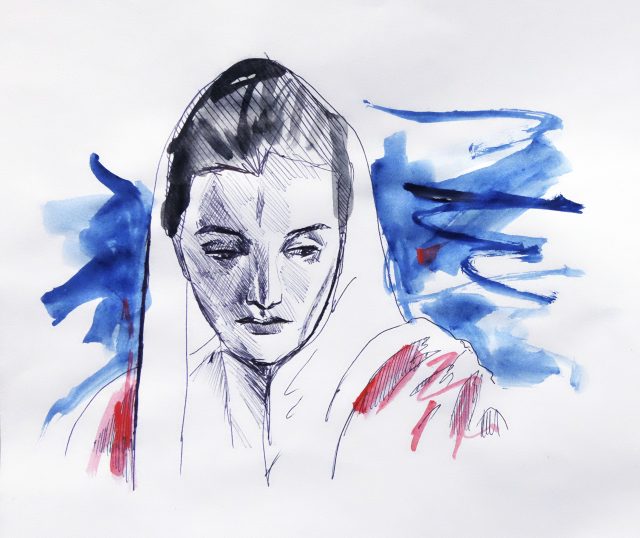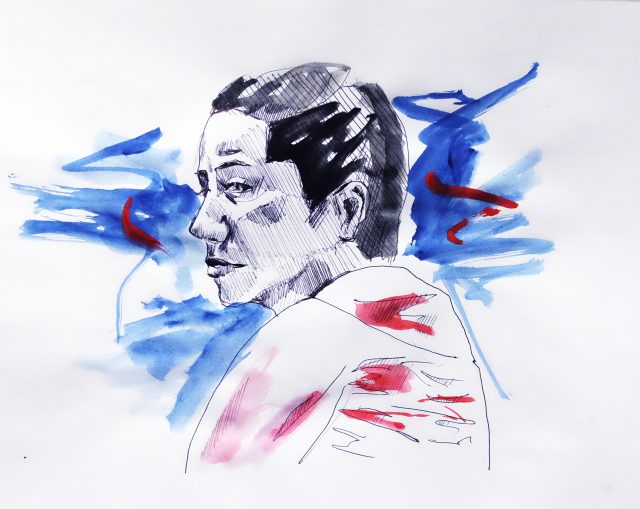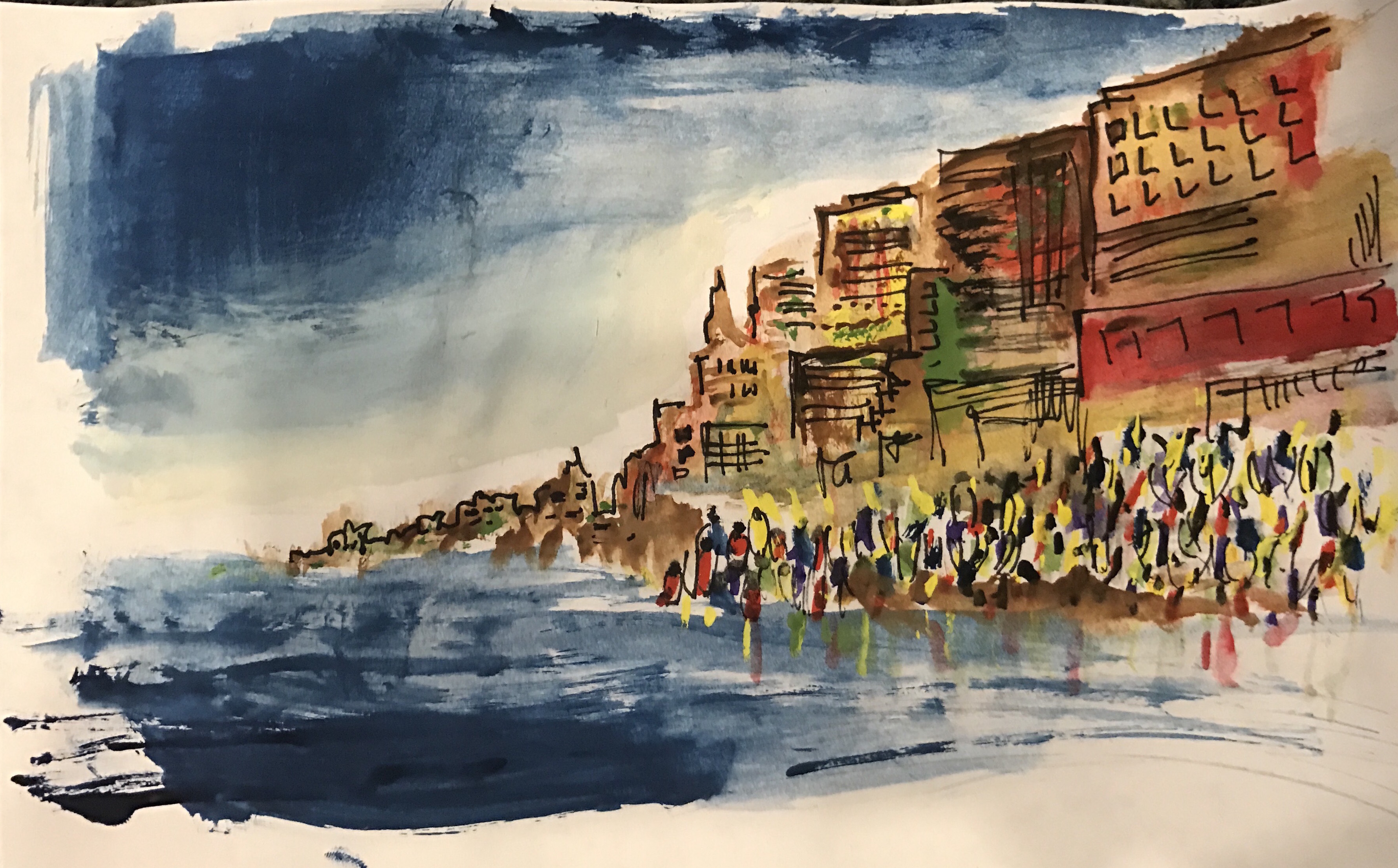Content warning: sexual violence, misogyny
This review contains spoilers for Deepa Mehta’s Water.
Since her entrance into Indian cinema in the nineties, Deepa Mehta’s films have danced on the sharp edges of intersecting transnational feminist discourses. Mehta’s reputation precedes her: she is known both in India and in the American film world for pushing the envelope, and for telling the stories no one else is willing to. Born in Amritsar, India, Mehta now lives and works in Toronto, where much of her work is produced. The move was likely in part due to the difficulties she has faced in India as a filmmaker, particularly hostility from religious and political opponents. They saw her work as a threat to the status quo and pre-existing foundations of tradition, and thus sought to bar it from viewership by Indian audiences.
On January 18, Bar Le Ritz PDB screened Deepa Mehta’s Water as the 13th instalment of FEMMES FEMMES, a series of monthly film screenings, which collect donations for local charities aiding women and children. The series is organized by local artists Anika Ahuja and Rebecca Ladds and aims “to highlight strong female presence in cinema,” specifically focusing on the intersections of violence, sexuality, and mental health in feminist discourses.
Mehta’s reputation precedes her: she is known both in India and in the American film world for pushing the envelope, and for telling the stories no one else is willing to.
The Elements Trilogy, Mehta’s most notable and controversial work, began in 1996 with Fire, a film about two Indian women, sisters-in-law, who fall in love with one another while stuck in loveless marriages to cruel and uncaring men. Earth, the next in the trilogy, came out in 1998. It tells the story of a young girl growing up amidst the strife and violence of the 1947 partition of India, after the country gained freedom from the British. Both these films open up dialogues which Indian cultures and people often attempt to suppress – the former, regarding romantic relationships between women, and the cruelty of the heterosexual relationships in which they are trapped, and the latter, regarding the ongoing violence and ethno-religious disputes between Hindu, Sikh, Muslim, and Parsi people in India. Mehta holds a mirror up to Indian audiences and diasporic communities, forcing us to confront long-held prejudices we perpetuate through tacit approval. She calls Indian cultures out for their xenophobia, homophobia, misogyny, and the perpetuation of other forms of systemic violence.
While she is critical, I have yet to see a diasporic Indian filmmaker who does justice to India’s beauty in the way Deepa Mehta does. Raised in India and now part of the diaspora, I am moved by Mehta’s depiction of my country: something about it stirs within me the call to return – a reminder that while home is halfway across the world, it is also deep inside my own bones, embodied through the experiences of my mother, and her mother before that, and her mother before that. I find myself simultaneously on the outside of the stories she tells and deep within them. While both the time and locale are outside of my lived experiences, Mehta’s stories occur within a legacy of womanhood built on the experiences of being a woman in India, rooted in Indian cultures and traditions. There is some universality to these experiences, and a part of me would like to hope that Indian women are deeply bonded to one another through these experiences, forming a greater female nationhood. But as someone who no longer lives in India, and who has been alienated to a significant degree by its current political climate, I also find myself outside of this sisterhood. I wonder if Deepa Mehta feels the same way.
[Mehta] calls Indian cultures out for their xenophobia, homophobia, misogyny, and the perpetuation of other forms of systemic violence.
Water (2005), the last in the Elements Trilogy, is no less controversial than its predecessors. Set in 1938 Varanasi, a city in northern India, Water unflinchingly depicts the experiences of Chuiya, an eight-year-old child bride who is widowed at the beginning of the film. As per a specific Hindu tradition, which is dictated in the sacred texts by Manu, “a virtuous wife is one who after the death of her husband constantly remains chaste and reaches heaven though she has no son.” The film follows Chuiya as she is sent to a widow’s ashram – a concept I find difficult to translate into English, except to perhaps describe it as a communal living space for people bound together by some sort of religious or sub-cultural identity. This is where she meets Kalyani, a beautiful young widow who makes the very human mistake of falling in love with a man when she has been forbidden from doing so, and Shakuntala, a solemn older widow who takes on a disarmingly affectionate maternal role in Chuiya’s life. The film is unapologetically focused on the development and exploration of these women, who exist in vastly different worlds despite occupying the same one.

In Kalyani’s world, her beauty renders her hypervisible to the men around her, to the extent that she is coerced into prostitution by the matriarch of the ashram. These same perceptions of beauty render Shakuntala invisible. With her dark skin and short-cropped hair, she is overlooked not only by men but also by the women of the ashram who take her for granted. With this invisibility comes a degree of agency: as Chuiya enters Shakuntala’s life, the static nature of Shakuntala’s life in the ashram is replaced by a sudden, desperate need to protect the innocence of a child. These maternal feelings enable Shakuntala to act boldly, in a way no other character in the film seems to be capable of.
But as someone who no longer lives in India, and who has been alienated to a significant degree by its current political climate, I also find myself outside of this sisterhood. I wonder if Deepa Mehta feels the same way.
By contrast, Kalyani’s actions often echo those of the men around her, both in love and in violence. Her decisions are influenced greatly by the man she is in love with, who she plans to leave the ashram for – this would have been an escape from the confines of widowhood, had he not let her down in the relationship’s greatest moment of struggle. Her final act is committed in pain and humiliation, informed by her experiences with both her lover and the man she is coerced into having sex with for “the benefit of the ashram,” according to its matriarch. Kalyani’s fate is a terrible one, and the blame for that lies largely with the men who made it so – and yet, her character left me wishing for greater depth and exploration, especially in comparison to Shakuntala or Chuiya. Perhaps this is why the fates of Kalyani and Shakuntala diverge so greatly, despite their origins in the same space. Both women find themselves sacrificing everything for love, as the film comes to a close, but in vastly different ways.
Water is, at its core, a plea for the protection of innocence. Chuiya remains a child despite having been married off in childhood, and widowed not soon after. She remains a child even after being abandoned at the ashram by her parents, who had no other choice according to the dictates of archaic Hindu custom – which they could have chosen to ignore, at the risk of social ostracism. But they do not deviate from what is expected of them. Although the isolation of widows in India is nowhere near as commonly practiced as it once was, it is still acknowledged as a form of social death, in which the widow becomes a shade of her former self, not permitted to interact with others in the same ways she once used to and barely allowed to be herself to the same degree she once was. When Chuiya enters the ashram for the first time, she meets the wicked matriarch Madhumati (who, I might add, is a crucial illustration of the ways in which misogyny can be enacted by and through women themselves) who says in Hindi, “Our holy books say that women are a part of men when they are alive. When husbands die, God knows, half of a woman dies too. How can a half-dead woman feel pain?” To this, Chuiya replies simply: “Because she is half alive.”
Water is, at its core, a plea for the protection of innocence.
At first, Chuiya makes everything around her softer, more open – especially Shakuntala and Kalyani. Kalyani becomes almost childlike when she’s around Chuiya, and this wistful optimism carries into her relationship with the young lawyer she falls in love with. There is hope, in that love, that tradition can be cast aside in favour of an unbreakable bond; that when she wishes to get re-married, which is a sin in widow ashrams, those who occupy positions of authority will step out of her way and allow her to do so. This love is so wrapped up in its own passion that neither of the lovers foresee the violent and traumatic end – dictated by custom and tradition – that they are bound to meet. Water ends on a dark and painful note, reminding audiences that innocence, while resilient, is not unbreakable – especially when faced with the cruelties of misogynistic sexual violence, of which both Kalyani and Chuiya are made victims.
Midway through Water, when Shakuntala is working in service of the local pandit (holy man), he asks her, “Shakuntala devi [goddess], you’ve been working with such sacrifice and devotion for so many years. Has it brought you any closer to self-realization?” To this, she answers gravely, that “if self-realization means a detachment from worldly desires, then no.” He replies swiftly, “Despite this – never lose your faith. Never.” Thus, Water also asks a pivotal – yet often unspoken – question to Indian audiences: what are we supposed to do when our faith fails us? Religion is deeply intertwined with Indian tradition and cultural ideology, but the values present within this rich history often push to the margins the most vulnerable members of Indian communities.

At surface level, Hindu tradition often associates womanhood with Godliness, but this is most often not embodied in the treatment of women by the state and its population. Rampant misogyny places burdens of labour (both emotional and physical) upon women, strips them of their agency and ability, and of course, enables the constant threat of rape culture for women of all ages. All of this has left me torn and confused over my feelings toward my own country. None of these problems are unique to India, and if I catch a non-Indian person criticising the prevalence of misogyny in India while not examining the same situation in their own nation, there will be hell to pay. However, they are problems that I have experienced and seen people I love experience them too. I have never been able to understand how a culture can claim to liken womanhood with Godliness, but still enact such violence upon these same women. To see these realities play out, and to not be able to do anything to help my sisters across the nation, breaks my heart.
If I catch a non-Indian person criticising the prevalence of misogyny in India while not examining the same situation in their own nation, there will be hell to pay.
The place of men in this film is an ambivalent one. Until the last two minutes of the film, I found myself not caring at all for the main male character in the film, Narayan – the young lawyer with whom Kalyani falls in love. One might describe him as a “soft boy,” in contemporary Internet slang – he plays the flute while sitting at the riverside waiting for his true love to arrive at nightfall, he has a picture of Mahatma Gandhi on his wall, and he engages in discourse on the liberation of India from the British and of the widows of India from their own archaic ideas. But where does this translate into action? Narayan’s presence in the film is a passive one – spurring only negative plot points, if anything – that until this point I have mentioned him a grand total of once. I would argue that his presence exists solely to bring the film to its conclusion, which turns the face of the audience toward the hope of a brighter future, one where Chuiya is rescued from the strife of a widow’s life.
The whole film is oriented toward this yearning for something better. I find that this is true for many of the films coming out of India, both in the past and present. This sentiment began even before the independence of India from the British – there has always been a sense that the nation is collectively reaching out, trying desperately to grab hold of a future which promises them better lives. You can see it today in the migration of people from rural to urban India, and from urban India to other parts of the world, in search of a better life. You can see it echoed in stories of the independence movement against the British, in which the whole country was gripped by the fiery will to take back what the British had stolen from them. You can see it in the ways the current government implements unwise and irrational economic and political policy, with the misguided belief that they will lead the country to a better future. You can see it in the love and fervour with which much of the population believes in a God, many Gods, all taking different forms in the vast and diverse systems of belief found across the country.
And you can see it in the way Shakuntala turns her face up to the sunshine in the final moments of Water, watching the departing train that carries her beloved Chuiya away from the pain of the ashram, and into the bright hope of a liberated future.
